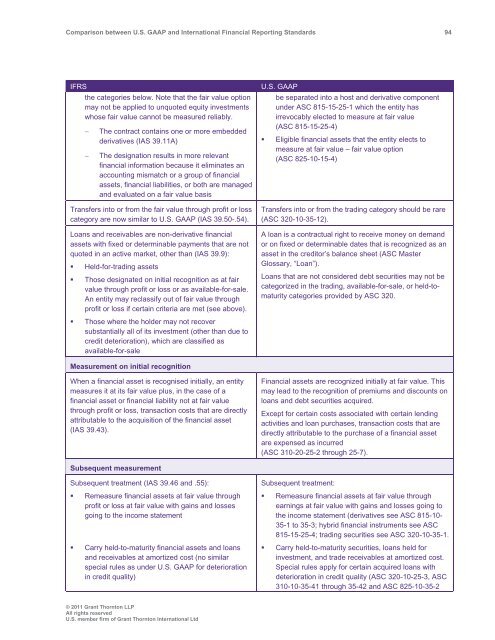Comparison between U.S. GAAP and International ... - Grant Thornton
Comparison between U.S. GAAP and International ... - Grant Thornton
Comparison between U.S. GAAP and International ... - Grant Thornton
Create successful ePaper yourself
Turn your PDF publications into a flip-book with our unique Google optimized e-Paper software.
<strong>Comparison</strong> <strong>between</strong> U.S. <strong>GAAP</strong> <strong>and</strong> <strong>International</strong> Financial Reporting St<strong>and</strong>ards 94<br />
IFRS<br />
the categories below. Note that the fair value option<br />
may not be applied to unquoted equity investments<br />
whose fair value cannot be measured reliably.<br />
<br />
<br />
The contract contains one or more embedded<br />
derivatives (IAS 39.11A)<br />
The designation results in more relevant<br />
financial information because it eliminates an<br />
accounting mismatch or a group of financial<br />
assets, financial liabilities, or both are managed<br />
<strong>and</strong> evaluated on a fair value basis<br />
Transfers into or from the fair value through profit or loss<br />
category are now similar to U.S. <strong>GAAP</strong> (IAS 39.50-.54).<br />
Loans <strong>and</strong> receivables are non-derivative financial<br />
assets with fixed or determinable payments that are not<br />
quoted in an active market, other than (IAS 39.9):<br />
• Held-for-trading assets<br />
• Those designated on initial recognition as at fair<br />
value through profit or loss or as available-for-sale.<br />
An entity may reclassify out of fair value through<br />
profit or loss if certain criteria are met (see above).<br />
• Those where the holder may not recover<br />
substantially all of its investment (other than due to<br />
credit deterioration), which are classified as<br />
available-for-sale<br />
U.S. <strong>GAAP</strong><br />
be separated into a host <strong>and</strong> derivative component<br />
under ASC 815-15-25-1 which the entity has<br />
irrevocably elected to measure at fair value<br />
(ASC 815-15-25-4)<br />
• Eligible financial assets that the entity elects to<br />
measure at fair value – fair value option<br />
(ASC 825-10-15-4)<br />
Transfers into or from the trading category should be rare<br />
(ASC 320-10-35-12).<br />
A loan is a contractual right to receive money on dem<strong>and</strong><br />
or on fixed or determinable dates that is recognized as an<br />
asset in the creditor’s balance sheet (ASC Master<br />
Glossary, “Loan”).<br />
Loans that are not considered debt securities may not be<br />
categorized in the trading, available-for-sale, or held-tomaturity<br />
categories provided by ASC 320.<br />
Measurement on initial recognition<br />
When a financial asset is recognised initially, an entity<br />
measures it at its fair value plus, in the case of a<br />
financial asset or financial liability not at fair value<br />
through profit or loss, transaction costs that are directly<br />
attributable to the acquisition of the financial asset<br />
(IAS 39.43).<br />
Financial assets are recognized initially at fair value. This<br />
may lead to the recognition of premiums <strong>and</strong> discounts on<br />
loans <strong>and</strong> debt securities acquired.<br />
Except for certain costs associated with certain lending<br />
activities <strong>and</strong> loan purchases, transaction costs that are<br />
directly attributable to the purchase of a financial asset<br />
are expensed as incurred<br />
(ASC 310-20-25-2 through 25-7).<br />
Subsequent measurement<br />
Subsequent treatment (IAS 39.46 <strong>and</strong> .55):<br />
• Remeasure financial assets at fair value through<br />
profit or loss at fair value with gains <strong>and</strong> losses<br />
going to the income statement<br />
• Carry held-to-maturity financial assets <strong>and</strong> loans<br />
<strong>and</strong> receivables at amortized cost (no similar<br />
special rules as under U.S. <strong>GAAP</strong> for deterioration<br />
in credit quality)<br />
Subsequent treatment:<br />
• Remeasure financial assets at fair value through<br />
earnings at fair value with gains <strong>and</strong> losses going to<br />
the income statement (derivatives see ASC 815-10-<br />
35-1 to 35-3; hybrid financial instruments see ASC<br />
815-15-25-4; trading securities see ASC 320-10-35-1.<br />
• Carry held-to-maturity securities, loans held for<br />
investment, <strong>and</strong> trade receivables at amortized cost.<br />
Special rules apply for certain acquired loans with<br />
deterioration in credit quality (ASC 320-10-25-3, ASC<br />
310-10-35-41 through 35-42 <strong>and</strong> ASC 825-10-35-2<br />
© 2011 <strong>Grant</strong> <strong>Thornton</strong> LLP<br />
All rights reserved<br />
U.S. member firm of <strong>Grant</strong> <strong>Thornton</strong> <strong>International</strong> Ltd
















